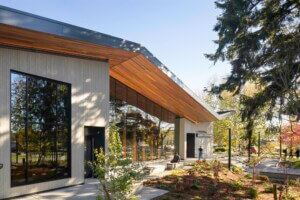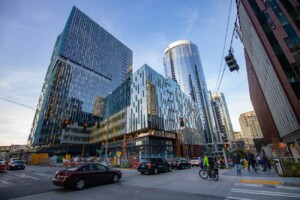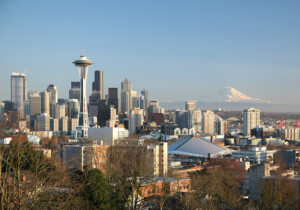Awarded the 2016 AIA National Architecture Firm Award in December 2015, LMN Architects is having a moment. Perhaps most well known for its large urban projects—convention centers, performing arts centers and urban infrastructure—the Seattle firm has worked out of its downtown Seattle office in the 1959 international style Norton Building for the past 30 years. Founded in 1979, LMN is a one-studio firm with close to 150 employees. Its 40,000-square-foot office spans two-and-a-half floors.
“We believe the best way to comprehensively understand a space is to build physical models,” said LMN partner John Chau. “Models don’t lie…That’s why we like this building. It allows us to have spaces to do that.” The LMN office is mainly an open plan with downtown views, column-free studio spaces, model building areas, and conference rooms. A lower floor hosts LMN’s in-house digital fabrication shop. There’s a dual gantry CNC mill that LMN built about a year ago that features two cutting machines on a single cutting bed.
LMN discussed the challenges of building in the future: With less available land, sites will get smaller, necessitating building more efficiently and vertically to accommodate denser layers—more people, more infrastructure, and more ecology in the same space. “We no longer are just simply architects,” said Chau. “The need for all of us to collaborate more, communicate more, is even more critical—it’s important to know what the city council is thinking about, what its leads are. And it’s going back to being very informed citizens—we have the gift, ability, and the responsibility to help solve a lot of issues that arise.”
Tobin Center for the Performing Arts
San Antonio, TX
The performing arts center opened late 2014—an effort to reinvigorate the 1926 San Antonio Municipal Auditorium designed by architect Atlee Ayres that had become outdated. “We built a new auditorium, but rotated the geometry to create a new outdoor space and new entry to the San Antonio River Walk,” said LMN partner Mark Reddington. LMN kept the historic facade and added a new structure, clad in a textured metal veil. The shroud encloses the auditorium and filters the light in different colors and angles. The interior lobby hosts custom tiles that curve in plan and section—each row shifts, creating a negative volume.
Inside the main concert hall, a perforated wood fascia backlit with LEDs allows for an array of colorful effects. The hall can hold up to 1,738 seats and 2,100 people with a flat floor setup. The performance hall also contains the first gala floor system in the U.S. The seats sit on motorized platforms that can fold over, creating a flat floor that can be used for other types of events like rock concerts. Inside the performing arts center is a 295-seat studio theater and the outdoor plaza facing the San Antonio River can hold up to 600 seats.
University of Iowa Voxman Music Building
Iowa City, IA
Opening October 2016, the new 180,000-square-foot music school for the University of Iowa will replace the previous one sited along the Iowa River that flooded in 2008. LMN moved the new building 50 feet up the hill, orienting it with the center of the college town. The mostly glass exterior building will hold a 700-seat concert hall, a recital hall with 200 seats, and rooms for pipe organs, classes, rehearsal areas, and faculty. “We wanted to create a building that was an extension of the public experience of the street, so that people could wander in, go to a performance at the music school, or students could come in and visit a professor,” said Reddington.
The building’s small footprint necessitated going vertical, stacking up to five stories of isolated music rooms. LMN developed a theatroacoustics system, a high-performance ceiling system that optimizes acoustics while hiding some of the structural elements such as speakers, microphones, fire sprinklers, and stage lights. “[The theatroacoustics system] was actually a money saving move,” said LMN partner Stephen Van Dyck. “They’re all put together in one gesture. It kind of becomes transcendent beyond any one of those individual pieces,” said Reddington.
Vancouver Convention Centre West
Vancouver, BC, Canada
After a series of false starts and shifting sites, LMN knew its design for the west addition to the Vancouver Convention Centre would finally happen if Vancouver won the 2010 Olympic Winter Games bid. The project was included in the bid as the media center. When the architects saw the front page of the Vancouver Sun with the winning news, they knew they would get the green light. “That’s how we knew it was real,” said Chau. The 1.2-million–square-foot convention center addition was completed in 2009. It occupies 22 acres—14 acres on land, eight acres over the water—of what was once a brownfield site.
The convention center boasts a six-acre green roof with 240,000 bees producing honey for the convention center restaurant. The interiors feature local British Columbia wood. The project also supports the maritime harbor ecosystem. “It’s linked into the landscape, habitat, and shore system,” said Reddington. “There’s a marine habitat that goes around the edge of the building and underneath.” LMN used the concrete loading dock as the infrastructure to support a reef, said Van Dyck.
Sound Transit U Link University of Washington Station
Seattle, WA
LMN designed the University of Washington light rail station and surrounding open space that opened in March 2016. The boarding platform can accommodate up to 1,600 people. “We had to link in all of this stuff—a bridge, a bicycle pathway, a head house, escalators, stairs, and then the station block underground that is 500 feet long,” said Reddington. Perhaps the most challenging, but rewarding, part of the project was designing the smoke chamber. “For fire requirements you have to create a big smoke chamber,” said Reddington. “If there is a fire somewhere, it helps isolate the fire so people can get out and not have smoke running all the way through the entire station.”
LMN worked with Seattle artist Leo Saul Berk, who created “Subterranium,” an installation made with nearly 9,000 square feet of custom deep blue metal backlit panels that wrap the smoke chamber. The panels tell the story of the site’s geology. “By integrating a lot of things into a single system, you have the capacity of one system to solve many problems—like a smoke enclosure that is now the main sculptural expression of a subway station,” said Van Dyck.










